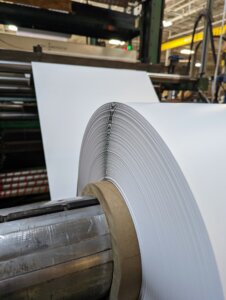Slot Die Coating Application: The Must-Know Principles

We’ve got you covered. Check it out!
What are the Applications of Slot Die Coating?
When you consider slot die coating, you might assume that there is a single standard slot die coating application. However, that isn’t actually the case. You’ll find many different applications for this process, serving a variety of industries. Typically, we divide the applications into industrial applications and research applications.
We use industrial applications in manufacturing settings, often with long term profit in mind. Research applications tend to be more focused on experimentation. While the far reaching results found through research applications may eventually hit the market, for now they’re more theoretical—and represent great opportunities to test the limits of slot die coating.
The Industrial Uses
Consider the industrial applications of slot die coating a little more closely. If you’re a business owner, these applications may affect you more directly. Among the products and industries connecting to slot die coating and using equipment, you’ll find:
- Photographic film. When we first began using slot die coating in manufacturing, we often utilized it for the production of photographic film. The flexibility of slot die coating makes it easier to create the kind of thin, flexible material you expect from photographic film—while at the same time maintaining consistency. In a similar manner, another common slot die coating application is the production of photographic papers. These papers require many of the same elements you’ll need from photographic film.
- Flexible packaging. Another flexible product we make through slot die coating is flexible packaging. You need this kind of packaging to be easily stretched, and adaptable to wrap around many different final products. At the same time, you don’t want to sacrifice the durability of the packaging, which some processes can. Slot die coating provides the best of both worlds.
- Transdermal and oral pharmaceutical patches. In general, it shouldn’t be surprising that the medical device industry relies upon slot die coating as much as it does. There’s a great need for easily manipulated products in that sphere, and slot die coating can accommodate it.
- Adhesive films. Not only do adhesive films need to be flexible in terms of application—they also need to sustain the application of an adhesive coating. The slot die coating process ensures this. Think about how often we need adhesive film products across manufacturing and packaging. It’s no wonder that slot die coating remains so in demand.
Research of the Process
Now let’s turn to the other category of slot die coating application—research. The reason why slot die coating has become more popular in the research sphere is because of the more recent interest in nanomaterials and functional thin film devices. As a process, it is flexible, predictable, and easy to repeat—all elements that make it conducive to research. The most common types of research that require slot die coating surround printed, flexible, and organic electronics. However, we don’t use this process in research exclusively for those purposes. Other applications include:
- Water purification. We use slot die coating in the context of water purification to produce nanofiltration membranes.
- Biodegradable packaging. In this context, we utilize slot die coating to create multilayer barrier foils, placed against sustainable materials.
- Printed diagnostics and molecular sensors. Through slot die coating application, we can produce both ion selective membranes and active layers.
- Water electrolysis and fuel cells. In this context, we use slot die coating to produce electrode catalyst coatings and electrolytes.
What is the principle of a slot die coating application?
On a basic level, think of slot die coating as a technique for depositing one material onto another. You’re taking a solution and applying it onto a substrate. Usually, we accomplish this by using a narrow slot, which we position close to the substrate’s surface.
You’ll often hear manufacturers refer to the solution as “ink”, whereas the delivery device is a “slot die head”. When utilizing a slot die coating system, remember that that the slot die head is the most important component.
How does slot die coating work?
Now that you know the most elemental principles of slot die coating, let’s explore how it works on a more practical level. Moreover, let’s understand how the machine actually works.
As you work through the slot die coating process, you’ll place the slot die head close to the substrate. During this time, we’ll keep the substrate moving. The solution or “ink” leaves the slot die head and enters one of two constrained channels. One of these channels moves upstream, while the other moves downstream. All of this proceeds with the ultimate goal of the solution exiting the slot die head and entering the gap between the substrate and the head.
The gap between the substrate and the head—and specifically the gap height—determines the thickness of the solution application. Additionally, the slot die head is essentially stationary, while the substrate moves at a set speed. This means you can vary the flow rate, ultimately giving you more control throughout the slot die coating process.
That’s just scratching the surface of the process, but it’s a great start. Of course, we can explore other variables of slot die coating (and how you can modify it) further. Begin by contacting CTI here, or calling us at 419-924-5566. We’re happy to walk you through this system—and your options if you need to pursue it further!
- << < Previous Post
- 1
- 2
- ...
- 20
- ...
- 241
- 242 Next Post > >>

